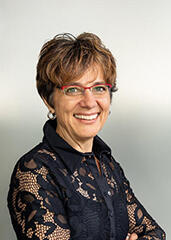
 Martin Bechthold, the Kumagai Professor of Architectural Technology at the Harvard School of Design, and Mary Tolikas, Chief Innovation Officer at the Dana Farber Cancer Institute and Visiting Lecturer on Engineering Sciences at the Harvard John A. Paulson School of Engineering & Applied Sciences, work together to teach Independent Engineering Design Project I & II, a small, seminar-size course for second-year students in the Master in Design Engineering program. Students spend the academic year designing prototype solutions to real-world problems about which they are passionate. Throughout the two semesters, students work towards understanding the complexity and dynamics underlying the problem and, by collaborating with relevant stakeholders, they explore visionary solutions and iterate on prototypes that would best address their challenge. Analyzing and quantifying potential impact is central to solution development. Early in the course, students are placed in self-selected “affinity groups,” based on shared interests. Students use these groups throughout the term to bounce ideas from and relay feedback. They also receive regular feedback from faculty advisors throughout each stage as they continue to evolve their project.
Martin Bechthold, the Kumagai Professor of Architectural Technology at the Harvard School of Design, and Mary Tolikas, Chief Innovation Officer at the Dana Farber Cancer Institute and Visiting Lecturer on Engineering Sciences at the Harvard John A. Paulson School of Engineering & Applied Sciences, work together to teach Independent Engineering Design Project I & II, a small, seminar-size course for second-year students in the Master in Design Engineering program. Students spend the academic year designing prototype solutions to real-world problems about which they are passionate. Throughout the two semesters, students work towards understanding the complexity and dynamics underlying the problem and, by collaborating with relevant stakeholders, they explore visionary solutions and iterate on prototypes that would best address their challenge. Analyzing and quantifying potential impact is central to solution development. Early in the course, students are placed in self-selected “affinity groups,” based on shared interests. Students use these groups throughout the term to bounce ideas from and relay feedback. They also receive regular feedback from faculty advisors throughout each stage as they continue to evolve their project.
Designing solutions in response to real-world problems
The benefits
“They continue to learn to become comfortable with being uncomfortable,” Bechthold explains, referring to working on open-ended problems. By collaborating across many viewpoints, students get a richer sense of how thorny a problem really is and that there is no finite, finished answer. Through this, Tolikas notes that students learn to be “tenacious” and to learn from each other’s views, especially across concentrations in either engineering or design. The class structure gives them the space to support each other and to be truly creative in response to something they are passionate about.
"Give students the opportunity to imagine.”
The challenges
A core challenge of this program structure is maintaining the flexibility for students to explore the wide range of projects they are interested in, which often leads to ’pivoting’ from one project to another mid-course, as well as different timelines. Some students may immediately know what they want to pursue, for instance, while others need more time. Bechthold and Tolikas emphasize creating dynamic workshops that are widely useful across projects in a domain and structuring the classroom so the whole class is supportive of each other’s evolving needs. They also note that this would simply not be possible with an overly large course size and caution other professors to be mindful of enrollment numbers when taking on this design.
Takeaways and best practices
-
Recognize and train students to look for racial bias in research methodologies.
Bechthold and Tolikas note that they train students on the potential for racial bias in their own work, both through racial bias workshops and through feedback throughout the yearlong process. “Bias is pervasive throughout the process,” Tolikas explains, and so they try to challenge students at every stage throughout the year to be more attuned to identifying and counteracting bias in their solutions. -
“Give students the opportunity to imagine.”
Tolikas notes that, unlike the typical approach of just jumping in to see what you can solve, giving the students freedom without constraints to dream up big solutions can encourage even more creative results. “Allow the student the breathing room to think out of the box and without any constraints, to be extremely innovative, and then bring it back into the constraints of society.” -
Consider adding affinity groups to independent work.
Linking students with shared interests allows them to balance what Bechthold calls the “collective intelligence” of the group with the independence of the individual. People can still pursue their own work but know that they have a place to go for questions and feedback, or to step back from their narrower focus on a given cross-section.
Bottom line
For faculty seeking to adopt a similar approach, Bechthold and Tolikas emphasize learning about the background of students on an individual basis to help encourage them throughout the process. They also note how important it is to find a great co-instructor with a different perspective so the teaching team can model for students how to live at the edge of their disciplinary comfort zone.
